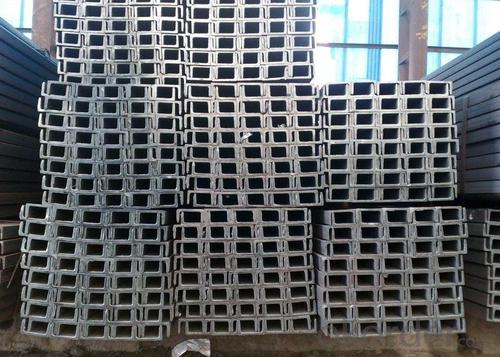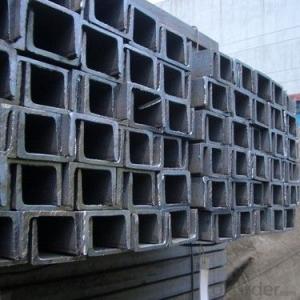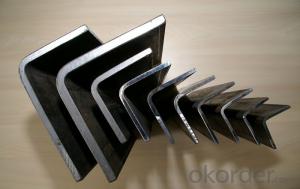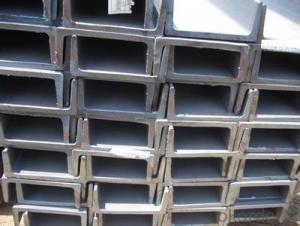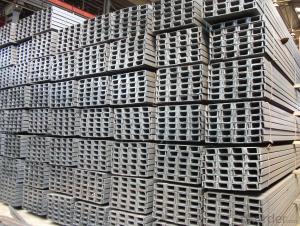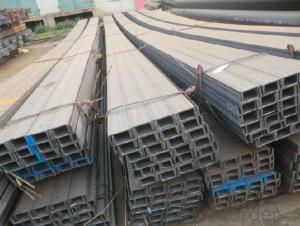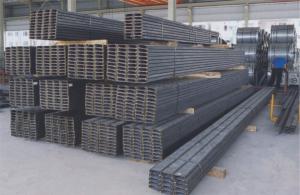Jis Channel
- Loading Port:
- Xingang Port
- Payment Terms:
- TT or LC
- Min Order Qty:
- 25 m.t.
- Supply Capability:
- 80000-100000MTS/YEAR m.t./month
OKorder Service Pledge
OKorder Financial Service
You Might Also Like
Specifications of JIS Channel:
1. We are definitely speciallizing in manufacturing and supplying channel steel as per japanese standard, which is characterised with high mechanical strength and competitive prices.
2. The sections in details are as followings in the table-1
|
JIS CHANNEL |
Standard h |
Sectional b |
Dimension s |
t |
Mass: Kg/m |
|
|
(mm) |
(mm) |
(mm) |
(mm) |
|
|
50x25 |
50 |
25 |
3.0 |
6.00 |
2.37 |
|
75X40 |
75 |
40 |
3.8 |
7.00 |
5.30 |
|
75X40 |
75 |
40 |
4.0 |
7.00 |
5.60 |
|
75X40 |
75 |
40 |
4.5 |
7.00 |
5.85 |
|
75X40 |
75 |
40 |
5.0 |
7.00 |
6.92 |
|
|
|
|
|
|
|
|
100X50 |
100 |
50 |
3.8 |
6.00 |
7.30 |
|
100X50 |
100 |
50 |
4.2 |
6.00 |
8.03 |
|
100X50 |
100 |
50 |
4.5 |
7.50 |
8.97 |
|
100X50 |
100 |
50 |
5.0 |
7.50 |
9.36 |
|
|
|
|
|
|
|
|
125X65 |
125 |
65 |
5.2 |
6.80 |
11.66 |
|
125X65 |
125 |
65 |
5.3 |
6.80 |
12.17 |
|
125X65 |
125 |
65 |
5.5 |
8.00 |
12.91 |
|
125X65 |
125 |
65 |
6.0 |
8.00 |
13.40 |
|
|
|
|
|
|
|
|
150x75 |
150 |
75 |
5.5 |
7.30 |
14.66 |
|
150x75 |
150 |
75 |
5.7 |
10.00 |
16.71 |
|
150x75 |
150 |
75 |
6.0 |
10.00 |
17.90 |
|
150x75 |
150 |
75 |
6.5 |
10.00 |
18.60 |
|
150x75 |
150 |
75 |
6.5 |
10.00 |
24.00 |
|
|
|
|
|
|
|
|
200X80 |
200 |
80 |
7.5 |
11.00 |
24.60 |
Table-1
3. The mechanical property of JIS Channel in the table-2:
|
Grade |
Yield Strength,N/mm² |
Extension Strength N/mm² | |||
|
Thickness of Steel,mm | |||||
|
≦16 |
>16-≦40 |
>40-≦100 |
>100 | ||
|
SS330 |
≧205 |
≧195 |
≧175 |
≧165 |
330-430 |
|
SS400 |
≧245 |
≧235 |
≧215 |
≧205 |
400-510 |
|
SS490 |
≧285 |
≧275 |
≧255 |
≧245 |
490-610 |
|
SS540 |
≧400 |
≧390 |
- |
- |
≧540 |
Table-2
4. The chemical composition of JIS Channel in the table-3
|
Grade |
Element(%) | |||
|
C |
Mn |
P |
S | |
|
SS330 |
-- |
-- |
≦0.050 |
≦0.050 |
|
SS400 | ||||
|
SS490 | ||||
|
SS540 |
≦0.30 |
≦1.60 |
≦0.040 |
≦0.040 |
Table-3
Usage of JIS Channel:
1.The JIS channel can be devided into two kinds, namely common channel steel and light channel steel. The sizes of hot rolled common channel steel range from 5# to 40#. Meanwhile, the channel steel can be divided into cold forming sectional equal channel steel, cold forming sectional unequal channel steel, cold forming inner edge channel steel and outer edge channel steel.
2.The JIS channel is usually used for arch-itechtural structure, and they could be welded in order to support or hang a vari-ety of facilities. They are also usually used in combination with I beam. The channel steel with sizes under 14# is usually applied to construction engineering, as purline, while the channel steel with sizes above 16# is more likely to be used in building vehicle chassis structure and mechanical structure. Furthermore, the channel steel in sizes above 30# are target at building bridge structure, as tension bar.
3.In a word, the channel steel must possess perfect welding property, riveting property and mechanical property and so on.
Package & Delivery of JIS Channel:
1.The JIS channel will be packed in bundle with steel wire at each end of every bundle and color marking in order to help the customer to recognize his goods more easily at sight.
2. And the JIS channel could be loaded into 20ft or 40ft container, or by bulk cargo.If the weight of each bundle reaches more than 3.5 mt, the loading by break bulk cargo should be choosed.When the weight of each bundle reaches less than 3mt, the loading by container should be choosed.
3.As for the transportaion from mill to loading port, the truck will be usually used. And the maximum quantity for each truck is 40mt.
4.All in all, we could do in accordance with customer's request.
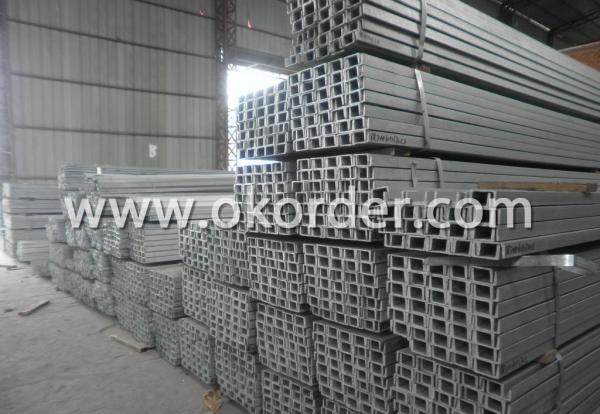
Production Flow of JIS Channel:
1.The steel billet shall be heated in the high temperature furnace.
2. The heated steel billet shall be rolled five to nine times with the aim of shaping the general figure of steel u channel.
3. The rolled steel channel should be put onto the cooling bed to make the temperature low.
4. The JIS Channel should be straighted on the straightener.
5. The straighted steel u channel will be cut into meters by saw, as per customer's requirements.
6. At the last part of production, the channel steel must be tested in order to confirm that the finished products are completely free from crack, pore, slag, scab or fold on the surface.
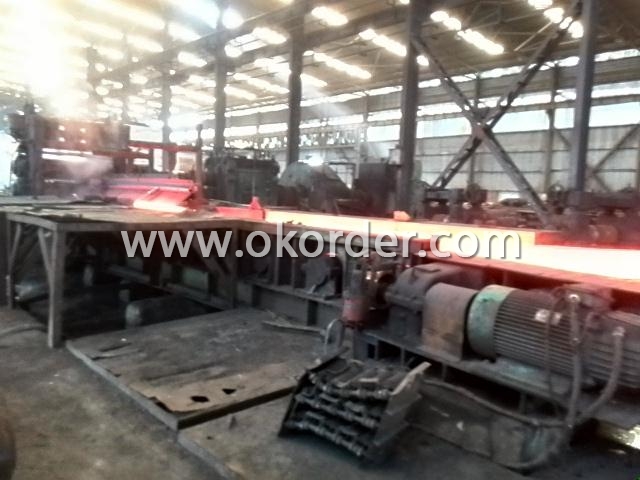
- Q: Are steel channels suitable for railway tracks?
- Railway tracks cannot be constructed using steel channels. Instead, a specialized type of steel rail is required for withstanding the immense weight and continuous usage of trains. Steel channels are typically utilized in construction for providing structural support and lack the necessary strength and durability to serve as railway tracks. Moreover, they do not possess the required shape and design features, including the appropriate rail profile and fastening system, necessary for ensuring the safety and efficiency of railway operations. Consequently, it is imperative to employ dedicated steel rails that are specifically designed for railway tracks to guarantee the functionality and safety of the railway system.
- Q: Do steel channels have any specific safety considerations?
- Indeed, specific safety considerations must be taken into account when dealing with steel channels. These channels are widely utilized in construction and industrial settings to provide structural support, but mishandling them can result in certain safety hazards. One aspect to consider is the weight and dimensions of steel channels. Due to their heaviness and unwieldiness, proper lifting techniques must be employed to prevent strain or harm to workers. Furthermore, caution should be exercised when working in proximity to or underneath steel channels to prevent potential accidents in the event of a fall or collapse. Another safety concern pertains to the sharp edges and corners of steel channels. These sharp surfaces can cause lacerations or punctures if adequate precautions are not taken. To minimize the risk of injury, workers should don appropriate protective gear, including gloves, safety glasses, and steel-toed boots. Additionally, fire safety should not be overlooked when working with steel channels. As steel is an excellent conductor of heat, steel channels can become hot during a fire incident. To minimize the spread of fire through these channels, suitable fire prevention measures and fire-resistant coatings should be implemented. Lastly, ensuring proper installation and maintenance of steel channels is crucial to uphold their structural integrity and safety. Regular inspections should be conducted to identify any signs of corrosion, damage, or fatigue. Promptly addressing any issues can prevent potential structural failures or accidents. In conclusion, although steel channels are known for their durability and widespread use, it is vital to be mindful of the specific safety considerations associated with them. By adhering to proper safety protocols, workers can mitigate risks and maintain a safe working environment.
- Q: Can steel channels be used in theater and stage construction?
- The utilization of steel channels in theater and stage construction is possible. These structural components, known as C-channels or U-channels, possess great flexibility and are commonly employed in various construction applications, including theater and stage construction. They serve as a robust and enduring framework for the support and framing of various theater or stage elements, such as lighting fixtures, curtains, sound systems, and set pieces. Steel channels are particularly favored in theater and stage construction due to their exceptional strength-to-weight ratio. This feature enables the creation of lightweight yet sturdy structures. Moreover, these channels can be easily customized and tailored to meet specific design requirements through cutting, welding, and shaping. Additionally, they exhibit excellent resistance to fire, corrosion, and wear, rendering them suitable for prolonged use in the demanding theater and stage environment. The versatility of steel channels allows for their integration into various construction methods and designs. They can be utilized as structural support beams, trusses, or frames to establish platforms, catwalks, and other elevated structures. Furthermore, steel channels can be employed as curtain tracks, providing a seamless and reliable system for hanging and moving curtains and backdrops. Additionally, they serve as mounting brackets for lighting fixtures, speakers, and other equipment. Ultimately, steel channels are a widely chosen option for theater and stage construction due to their strength, durability, and versatility. They offer the necessary support and framework for creating secure and functional theatrical spaces, while also allowing for creative design possibilities.
- Q: Can steel channels be customized to specific lengths?
- Indeed, it is possible to customize steel channels to meet specific length requirements. Although steel channels are typically found in standard sizes, they can be altered or trimmed to match the desired length. This customization process entails cutting the steel channel to the desired length and may also involve implementing welding or other techniques to uphold its structural integrity. The ability to customize steel channels offers enhanced flexibility in a variety of construction and engineering applications.
- Q: Can steel channels be used for both residential and commercial construction?
- Steel channels are suitable for both residential and commercial construction. These versatile structural components can be utilized in a variety of ways, such as in the construction of building frames, support beams, and walls and ceilings. Due to their strength and stability, they are well-suited for both residential and commercial projects. Furthermore, steel channels offer durability, fire resistance, and a high load-bearing capacity, making them an excellent choice for construction projects of various sizes and types.
- Q: Can steel channels be used for equipment supports?
- Indeed, equipment supports can make use of steel channels. In construction and industrial settings, steel channels are widely employed due to their robustness and durability. They are capable of providing steadfast and dependable support for a range of equipment, including heavy machinery, tools, and other substantial loads. These steel channels are specifically designed to endure substantial loads and can be easily customized and installed to meet specific support requirements. Furthermore, they can be combined with other structural components, such as beams and columns, to establish a resilient support system. All in all, steel channels serve as a dependable solution for equipment supports, owing to their strength, versatility, and enduring performance.
- Q: How do steel channels perform under static loads?
- Steel channels, commonly utilized in construction and engineering applications, serve as structural components. Their performance proves outstanding when subjected to static loads, such as the weight of structures or equipment resting upon them. One notable advantage of steel channels lies in their impressive strength-to-weight ratio. Despite being relatively lightweight, they possess the ability to support heavy loads. Steel, renowned for its exceptional strength and durability, showcases these qualities in the performance of steel channels under static loads. Moreover, steel channels exhibit good resistance against deformation and deflection. When a static load is applied, these channels evenly distribute the load and resist bending or sagging. As a result, the stability and integrity of the supported structure or equipment remain intact. Additionally, steel channels boast high resistance to corrosion and environmental factors. This renders them suitable for various conditions, including outdoor and industrial environments. Furthermore, their corrosion resistance contributes to their longevity and low maintenance requirements. Aside from their mechanical properties, steel channels can be effortlessly fabricated and installed. They are available in a wide array of sizes and dimensions, allowing for flexibility in design and construction. Steel channels can be connected securely and reliably through welding or bolting. In summary, steel channels deliver exceptional performance under static loads. Their high strength, resistance to deformation, and durability establish them as a dependable choice for supporting structures and equipment.
- Q: How do steel channels contribute to the overall cost-effectiveness of a building?
- Steel channels contribute to the overall cost-effectiveness of a building by providing structural support and reducing the need for excessive materials. These channels are versatile and can be easily fabricated to fit specific requirements, which reduces waste and construction time. Additionally, steel channels have high strength-to-weight ratio, allowing for lighter building designs and lower transportation costs. Their durability and resistance to corrosion also result in long-term cost savings by minimizing maintenance and replacement expenses.
- Q: What are the considerations for steel channel bracing?
- Some considerations for steel channel bracing include the load requirements, structural stability, connection details, material specifications, and the overall design intent. The bracing should be designed to resist the applied loads and provide adequate support to prevent buckling or excessive deflection. The connection details must be carefully planned to ensure proper transfer of forces between the bracing and the main structure. Additionally, the material specifications should be chosen based on the specific project requirements, considering factors such as durability, corrosion resistance, and fire resistance. Overall, the design of steel channel bracing should be carefully evaluated to ensure it meets the desired safety and performance criteria.
- Q: Can steel channels be used for shelving systems?
- Indeed, shelving systems can utilize steel channels. By virtue of their strength and durability, steel channels prove to be well-suited for bearing substantial loads. Their ability to be effortlessly affixed to walls or alternative structures yields a stable and robust shelving system. Moreover, the assortment of sizes and lengths in which steel channels are available permits customization to cater to distinct storage requirements. On the whole, owing to their vigor and adaptability, steel channels are widely favored for shelving systems in warehouses, garages, and various industrial environments.
1. Manufacturer Overview
| Location | Tangshan, China |
| Year Established | 2000 |
| Annual Output Value | Above US$ 50 Million |
| Main Markets | Mid East; Southeast Asia; Korea |
| Company Certifications |
2. Manufacturer Certificates
| a) Certification Name | |
| Range | |
| Reference | |
| Validity Period |
3. Manufacturer Capability
| a) Trade Capacity | |
| Nearest Port | Tianjin |
| Export Percentage | 20% - 30% |
| No.of Employees in Trade Department | 10-20 People |
| Language Spoken: | English; Chinese |
| b) Factory Information | |
| Factory Size: | Above 81,000 square meters |
| No. of Production Lines | 1 |
| Contract Manufacturing | OEM Service Offered |
| Product Price Range | Average |
Send your message to us
Jis Channel
- Loading Port:
- Xingang Port
- Payment Terms:
- TT or LC
- Min Order Qty:
- 25 m.t.
- Supply Capability:
- 80000-100000MTS/YEAR m.t./month
OKorder Service Pledge
OKorder Financial Service
Similar products
Hot products
Hot Searches
Related keywords



